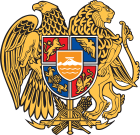- Constitution of Armenia
-
Armenia 
This article is part of the series:
Politics and government of
Armenia- Constitution
- President
- Prime Minister
- National Assembly
- Political parties
- Elections
- Administrative divisions
- Foreign relations
- Relations with the EU
- Human rights
See also:
The Constitution of Armenia was adopted by a nationwide referendum on July 5, 1995.[1] This constitution established Armenia as a democratic, sovereign, social, and constitutional state. Yerevan is defined as the state's capital. Power is vested in its citizens, who exercise it directly through the election of government representatives. Decisions related to changes in constitutional status or to an alteration of borders are subject to a vote of the citizens of Armenia exercised in a referendum. There are 117 articles in the 1995 constitution. On November 27, 2005, a nationwide constitutional referendum was held and an amended constitution was adopted.[2]
According to the November 2005 Constitution, the President of the Republic appoints the Prime Minister based on the distribution of the seats in the National Assembly and consultations with the parliamentary factions. The President also appoints (or dismisses from office) the members of the Government upon the recommendation of the Prime Minister.[3] Given the constitutional powers of the president, Armenia can be regarded as a presidential republic.
Early constitutional history and drafting of the 1995 constitution
Immediately after independence, the 1978 constitution, a replica of the Soviet Union's 1977 document, remained in effect except in cases where specific legislation superseded it. At the end of 1992, the president and the APM parliamentary delegates presented a draft constitution. They put forward a revised version in March 1993. Then, after nearly a year's work, a bloc of six opposition parties led by the Armenian Revolutionary Federation (ARF) presented an alternative constitution in January 1994 that would expand the parliament's power, limit that of the president, expand the authority of local government, allow Armenians everywhere to participate in governing the republic, and seek international recognition of the 1915 massacre. As 1994 began, observers expected a long struggle before parliament adopted a final version.[4]
See also
References
- ^ The First Constitution of the Republic of Armenia (5 July 1995)
- ^ The Constitution of the Republic of Armenia (27 November 2005)
- ^ The Constitution of the Republic of Armenia (27 November 2005), Chapter 3: The President of the Republic, Article 55.
- ^ Glenn E. Curtis and Ronald G. Suny. "The Constitution". Armenia: A country study (Glenn E. Curtis, ed.). Library of Congress Federal Research Division (March 1994).
 This article incorporates text from this source, which is in the public domain.
This article incorporates text from this source, which is in the public domain.
 Armenia topics
Armenia topicsHistory (timeline) EarlyOrigins · Name · Kura-Araxes culture · Hayk · Hayasa-Azzi · Mitanni · Nairi · Kingdom of Urartu · Orontid dynasty · Kingdom of Armenia · Roman Armenia · Byzantine Armenia · Bagratuni Armenia · Armenian Kingdom of CiliciaMiddleModernBy topicGovernment and
politicsConstitution · President · Prime Minister · National Assembly · Political parties · Elections · Foreign relations · Corruption · Human rights · LGBT rights · Relations with the European Union · more on government / politicsEconomy Armenian dram · Central Bank · List of companies · Armex · Agriculture · Industry · Communications · Transport · Energy · Mining · Waste management · International rankingsAdministrative
divisionsArmed Forces Geography Demographics Religion Culture Symbols States with limited
recognitionAbkhazia · Kosovo · Nagorno-Karabakh · Northern Cyprus · South Ossetia · Transnistria
Dependencies
and other territoriesOther entities European Union · Sovereign Military Order of MaltaStates with limited
recognitionDependencies and
other territories- Christmas Island
- Cocos (Keeling) Islands
- Hong Kong
- Macau

This article about politics in Armenia is a stub. You can help Wikipedia by expanding it.
